Copernicus here.
For those who don’t follow the site regularly, I’ve been reviewing movies for AICN for years, but in real life I’m a professional astronomer. So sometimes I like to weigh in on the scientific accuracy of films. Last year, I did this for AVATAR and even got to talk to James Cameron about it. My take is this: you can have as much fantasy as you want in films if it is important to the story, but just don’t get the details wrong out of laziness. I find it depressing, and it can sow misconceptions that I have to correct in my class (I teach at UC Santa Barbara). Some of what I’ll say here is nitpicking, but I think of it as a chance to sneak a little astronomy teaching into a film discussion.
I just saw the new GREEN LANTERN WonderCon footage...
...and I have to say I’m getting very excited! I love superhero films, and I love space fantasies. Put the two together and my excitement level is off the charts. We almost never get to see the full power of Hollywood unleashed on creating truly alien worlds, but it looks like that’s exactly what we’re going to see in GREEN LANTERN. Space travel, distant planets, and hordes of aliens – I just can’t wait.
First, I should say that I’m only a casual Green Lantern fan. I never read it growing up. I always thought little blue men with giant heads looked kind of stupid, even as a kid. I do like what little I’ve learned about the mythology since then. But my knowledge is limited to Wikipedia, the Secret Origins book we got in our BNAT goodie bag, GREEN LANTERN: FIRST FLIGHT, and what I’ve seen on JUSTICE LEAGUE UNLIMITED. The film should stand on its on though. It does look to me like they are doing a good job of translating the sometimes silly, sometimes awesome source material. Kilowog, Tomar-Re, and Abin Sur look spectacular – better than I could have imagined them from the comics. But how is GREEN LANTERN doing in terms of astronomy? Not too bad, actually. Let’s go in order through the footage.
The first astrophysically relevant thing that happens in the WonderCon footage is that Abin Sur is attacked and escapes in a pod, which is a very cool sequence. We see this in the background:

This is a bunch of galaxies. But notice the relative lack of stars. That is significant. Where is Abin Sur – in our galaxy, the Milky Way, or somewhere else? The footage cuts to Abin Sur, who says, “Heading to the nearest inhabited planet for the selection process.” When we cut back, his escape pod is still rotating out of control, implying that the new shot is a continuation of the above shot. And then we see this:
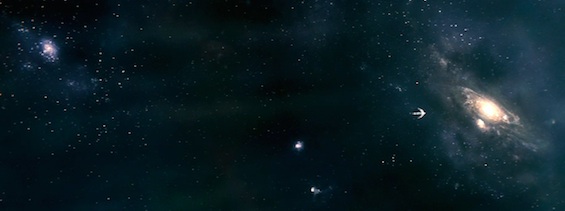
Ah ha! Looks like that is supposed to be the Milky Way. Notice the much higher number of stars in this direction. So it seems that Abin Sur was just outside of the Milky Way when he was attacked. There are a few things right and a few things wrong with this picture.
What’s right: Stars are mainly located within galaxies. That’s why in the first shot, looking away from the Milky Way, we see few stars – there is nothing out there but other galaxies. But when we look toward the Milky Way we see some stars far out in what is called the halo of the galaxy. Looks like there is some faint nebulosity (gas) in that direction too. I think it is pretty cool that they got this much of the picture right. Maybe they have a good science advisor!
What’s wrong: Traveling long distances within the galaxy is absurd enough in a spaceship, because the galaxy is 100,000 lightyears across. Still, you have to do that in science fiction using faster than light travel, or maybe hyperspace, because it is necessary to tell a good story. But traveling outside the galaxy is just batshit insane. The distances between galaxies are staggering – millions to billions of light years. But let’s say you could do it. You’d always want to be traveling through hyperspace. He’s not going to make it there in an escape pod unless that thing has hyperspace too.
There are billions of potential worlds in the Milky Way. If you are writing Green Lantern, why would you ever invoke other galaxies? It makes no sense. And yet, as far as I can tell, in the comics they did. Oa is supposed to be “at the center of the universe.” As far as we can understand cosmology there is no center to the universe. And yet, because every galaxy is expanding away from essentially every other galaxy, from every planet in the universe it looks to its inhabitants as if they are the center of the universe. So I take it from this that Oans are just poor cosmologists.
I read online that the so-called “Guardians of the Universe” on Oa have split the universe into 3600 sectors, with 7200 lanterns. Now there are approximately 100 billion galaxies in the observable universe (who knows how many in the whole thing). If they are truly guarding the whole universe, then there are about 15 million galaxies per Green Lantern. Each one of those has about 100 billion stars, so that is potentially 15 quadrillion solar systems per Green Lantern. If each Lantern lives for 100 years, and could teleport from solar system to solar system, he could only visit each one for 200 nanoseconds. These “Guardians of the Universe” are either the biggest morons in existence, or the universe is unbelievably sparsely populated, or they have delusions of grandeur.
Anyway, this is a limitation of the source material -- I suppose the early writers of the comics didn’t know a damn thing about astronomy, and people have just had to deal with it ever since. I’ll give the filmmakers the benefit of the doubt and assume they are kind of splitting the difference – Abin Sur is outside the Milky Way, but not too much outside. Or maybe even in the comics the Lanterns are restricted to the local group (everything I’ve read has been really vague about the extent of their influence).
But there is another problem. Abin Sur says, “Heading to the nearest inhabited planet for the selection process.” Now the Sun and Earth are about halfway from the center to the edge of the Milky Way. But Abin Sur is still a long way out! Is the Milky Way so sparsely populated that we are the closest inhabited planet? Looks to me like he’s got to go several hundred thousand lightyears yet. I hope that escape pod is a hot rod, and he’s not too badly injured. In the comic there is a reason he’s in a ship (he loses confidence in his ring), so at least there is a story reason for it.
Technically the galaxies we are seeing in this pan should be local group galaxies like Andromeda, M33, etc., since only those are close enough to the Milky Way be large like that. But who really cares if the artist just put in some random galaxies.
Overall verdict on this segment: the source material is crazy, but the filmmakers seem to be doing a reasonable job of interpreting it.
Next up, Hal Jordan gets his lantern. Look at this:
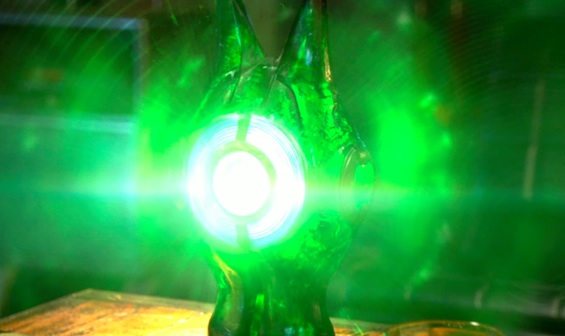
Looks like a Fresnel lens. Interesting. That’s a way of making parallel rays over a short focal length. Sometimes it is used in theater lights and lighthouses. Notice the waves of energy coming off the lantern. Interesting, and vaguely reminiscent of interference wave patterns:
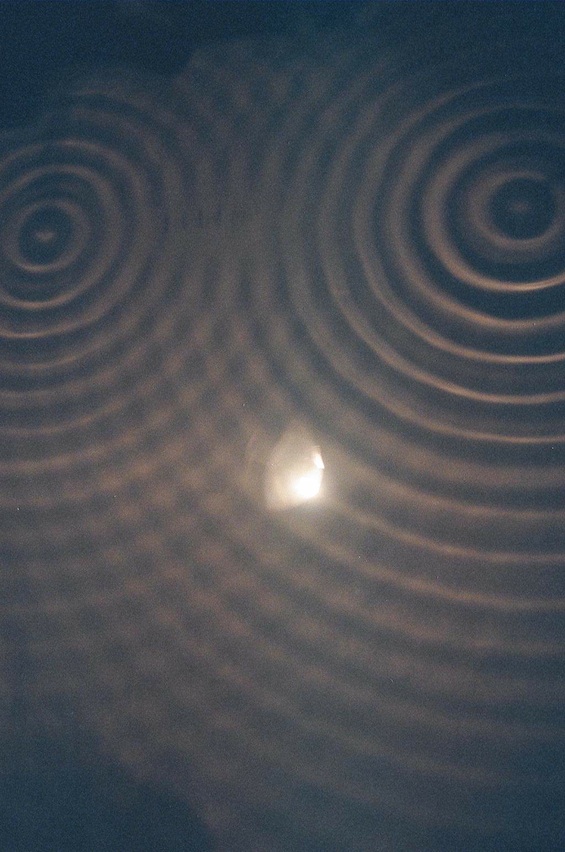
Now, is that what normal light coming out of a lantern like this would look like? No, but I have no idea what Green Lantern energy would look like, and it looks truthy, and so I like it!
Next, Hal figures out the GL oath, owing to something like possession by his ring, and shoots off into the sky:
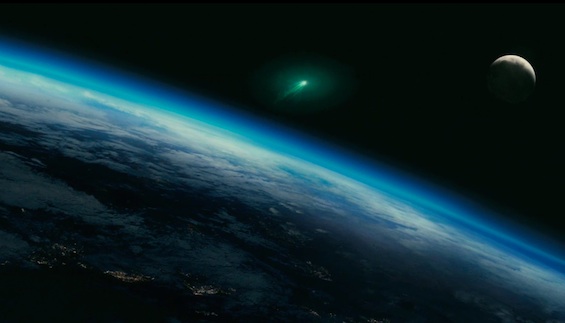
What can we say about this? For a start, your eyes would probably not see city lights and the illuminated part of the Earth at the same time like that. Your eyes can’t see contrast ratios that large. There are famous pictures like that, but they are composites. But it looks cool, so I have no problem with it.
Now, what else can we tell from this? The time of day. Hal Jordan lives in Coast City, in California (a fictional city near Edwards Air Force Base). So it looks like this image is oriented North-left, East into the picture. The Earth rotates such that the sun rises in the East, so this is hours before sunrise. If this happens immediately after the previous scene, it looks like Hal Jordan was staying up all night trying to figure out the oath.
And what phase is the moon? Waxing crescent! It orbits in the same direction as the rotation of the Earth, so you can tell it is a few days after new moon. You can see a waxing crescent moon in the morning, so that orientation is plausible.
The next shot shows Hal shooting past some astronauts working on the ISS.
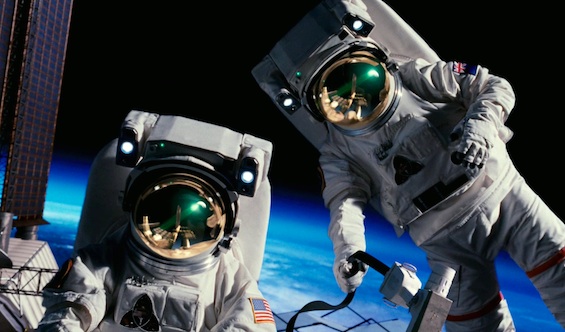
Interesting! The space suits are mostly accurate, but there are two problems. First, the top part is actually supposed to be rigid – it is actually called the HUT, or Hard Upper Torso. It isn’t here. And second, look at all the wrinkles in those suits! You can tell it was shot in a studio. In space the suits are under pressure, so they puff out. Compare this shot to a shot of my favorite astronaut, Mike Massimino (he fixed STIS, the instrument I use), when he was fixing Hubble:
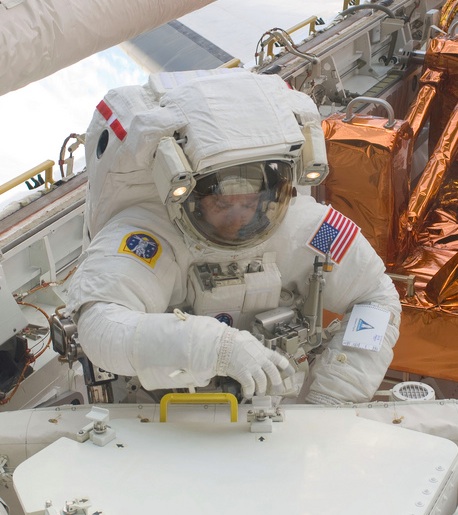
Why do I know so much about space suits? Mike Massimino and I are actually co-hosts of a TV show on National Geographic called Known Universe (premieres May 4). Here is Mike putting me in a space suit!
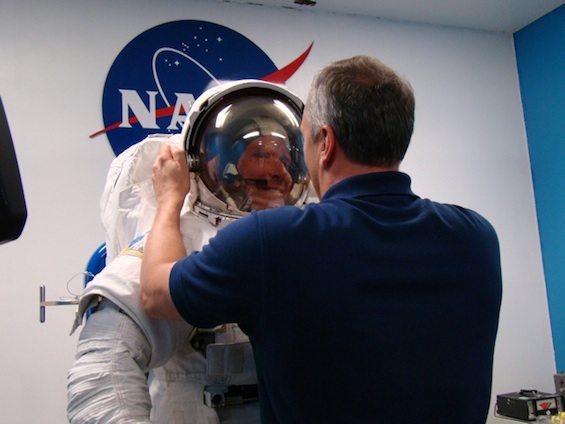
Notice that even though the air was on, my suit wasn’t under pressure. Check out the difference in size between the HUT and the sleeve due to the lack of inflation.
So why use stunt suits for filming, and not real ones, like the one I had on? First, real suits are expensive. And second, they are heavy – between 200 and 300 pounds. In the above picture my suit is actually attached to a stand to help support the weight. So all in all, I can’t really complain about the movie astronauts – after all, they are only on screen for about a second.
Back to GL. Hal Jordan goes into something like hyperspace (good, not traveling faster than the speed of light), and comes out near Oa. It looks like this:
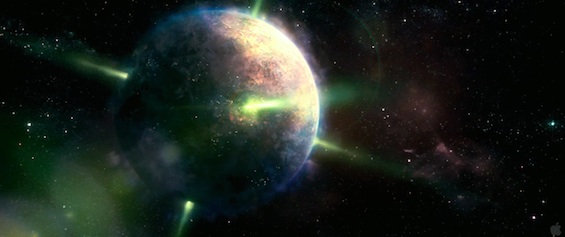
Pretty cool, if weird. I love to see new worlds! Not a very sharp terminator there (dividing line between night and day), which is kind of unphysical, but not too big a sin. The background looks ok.
What is Oa like as a world?
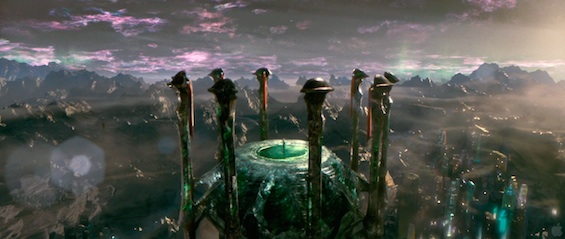
Pretty cool – lots of cloud cover and purple skies. Skies get their color because of Rayleigh scattering. Light is scattered off dust or molecules, according to the inverse of the 4th power of the wavelength. So short wavelength blue light is scattered a lot more than red light. That’s why on Earth the sky is blue (light scattered away from the Sun), and the sunset is red (blue light has been scattered out). Violet light is even shorter wavelength than blue (look at a rainbow), so on Oa, either the dust/molecule properties are different, or the light from Oa’s star is different than our Sun’s. We know its light can’t be too different than the Sun’s because the inhabitants of Oa seem to have an obsession with the visible part of the spectrum (why aren’t there ultraviolet or infrared lanterns). I digress – the bottom line is that Oa looks plausible enough, and cool at the same time.
And finally – aliens! I love these guys with the big eyes:
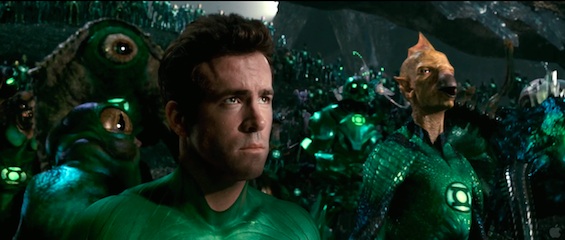
Since our eyes evolved to match the output of our sun (we see in the optical where it puts out most of its light), clearly other creatures will have eyes matched to their star. These guys have huge eyes – maybe they need a bigger aperture because their planet is farther away from its star, so the light is dimmer. Or maybe their planet is tidally locked and they evolved on the dark side. Nocturnal animals on Earth don’t have eyes that big, but whales and giant squid do. But I like to think instead their star puts out most of its energy in the infrared, and their eyes have to be bigger to resolve those longer wavelengths.
And while most of the lanterns are hominids (boo – see my AVATAR article for a rant on that), I really love the few that are just crazy, like jellyfish dude here:
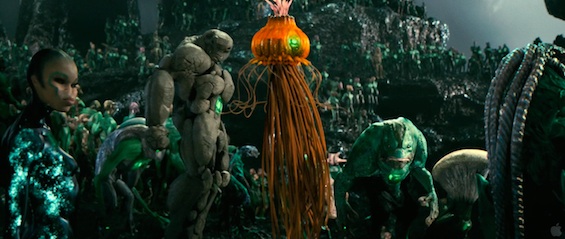
So all in all, from this brief glimpse, it looks like there is a lot to be excited about in the new GREEN LANTERN. It looks like they are taking both the source material and the astronomy seriously, which isn’t necessarily easy. I can’t wait to see the finished product.
